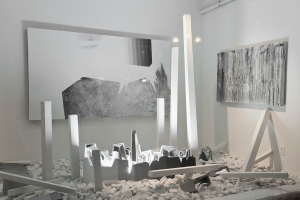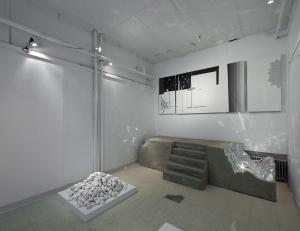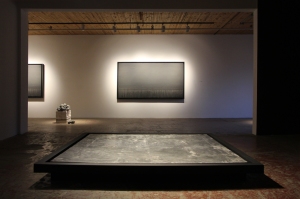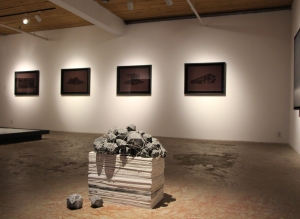L'arc-en-ciel n'existe pas
Montreal artist Simon Bilodeau's latest show at Art Mur is something of a culmination of many of the tendencies that have been present in his work for more than half a decade. Unlike other artists who concentrate on 'materiality', Bilodeau's is a resolutely cold sensibility devoid of any of the touchy-feely aesthetic touches that plague so much current abstract work. He constructs mausoleums, not party spaces. Bilodeau has said, Par ce choix plastique de n’utiliser aucune couleur, je consens à ne susciter aucune émotion par les couleurs utilisées, puisque celles-ci, je crois, tendraient par comparaison à prendre pour réalité ce qui est présenté. (By the choice not to use any plastic colour, I agree not to provoke any emotion by the colours used, since they, I think, tend to take compared to what is actually presented.) Which is to say, the painting (or sculpture) negates the emoticon function for the sake of the image.
 |
| At the end of the rainbow, 2008 |
 |
| Tu n'es qu'un etoile, 2009 |
On one level he was mocking the name, the cult of personality of the artist and the market value that comes with it. Projected into the future, the artist's implied immortality is a remarkably immobile one, stuck in the space with a leaden determination and encased in its own ruin. But the use of the name has another nuance. It functions as a depersonalized avatar, suspended in time like the immortality of an aristocratic name. Like the heads of the beasts which decorated the wall in Fuck Your Life, it has a heraldic function, symbolizing the point of indifference between life and death that is proper to a singularity, one which is paradoxically reproduced as itself and basically sterile.
 |
| Tu n'es qu'une etoile, 2009 |
Even any hint of bacterial life in his work has been killed off, if only apparently. The viewer is their to take that place, like dust. Kandinsky said that grey is 'an inconsolable immobility,' A sentiment ruthlessly mocked in Bilodeau's predominately grey work and his floating white block in Échec luxuriants. And it is hard not to recognize in these floating objects a mockery of the works of someone like Rachel Whiteread and her heavy handed history monuments, or Arte Povera's unintentional capacity to make urban decay more boutique friendly, softening the brutality of matter. Perhaps even more tellingly, his use of mirrored surfaces and heaps of rubble resembles the work of David Altmejd. If Altmejd is a romantic, in the best and worst senses of the word, Bilodeau is more of a realist and his satire more deliberate, more thoroughgoing, and unhampered by flirtations with affective redemption through campiness.
Grey, black, grey, silver white. They congeal into one another. There is always degree in his work though. This comes through aggregation and distance. Negative space is of great importance in his work. The audience fills it up as part-objects, rendered as anonymous as all other aspects of the work. The audience is nothing, but this nothing is important insofar as it occupies dead space. The greyness that verges on indifference that the works vaunt across the space seems almost fragile when first encountered. But as time goes by, the space fills up. The scale of the greyness begins to weigh.
 |
| Ce que l’on ne voit pas qui nous touche, 2014 |
It would be misleading to say these images present decay. Rather, they present the dead image of decay. This sets up a specific situation. The image takes the viewer as its object; the viewer's experience functioning as the decaying remainder of the image. To paraphrase Hobbes: an image is the decay of a thing. But the viewer is the decay of an image. More complexly, as a vehicle of decomposition (an organic creature), the viewer, by their presence, is an agent of contagion for the image as object. They function as a kind of death knell, more symbolically material than actually material, since the eyes stuck in the heads of these roving bodies register as less than light, less than dust. Their positive value is largely their contribution to dust (as rotting in presence) or as something that light can bounce off of.
 |
| Ce que l’on ne voit pas qui nous touche , 2014 |
(1) A few of those older works from Ce qu'il reste du monde were up in an adjoining room. They provided a near perfect complement to the show by Nicolas Grenier that was being shown on the ground floor. You can read me on Grenier a few years ago here.


No comments:
Post a Comment